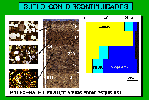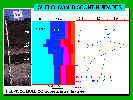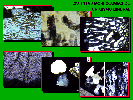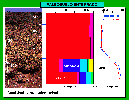The genetic relations between the geological substratum and the
overlying soil, as well as relations between soil horizons, can
be demonstrated by the mineralogy of this fraction.
![]() Lithological
discontinuities
Lithological
discontinuities
The assessment of the starting material's
homogeneity is an essential prior basis to assess the evolution
of certain edaphic parameters.
The starting material's homogeneity / heterogeneity can be demonstrated
by textural and mineralogical analysis methods (BARSHAD, 1955;
BREWER, 1964). The mineralogical methods are based on the distribution
of a stable or immobile specific mineral (quartz, zircon, tourmaline,
rutile,...), or even better by the variation of the ratio between
two stable minerals with regard to the depth. These analyses have
generally been carried out in fine sand and silt fractions (HASEMAN
and MARSHALL, 1945; BARSHAD, 1955; BREWER, 1964; SUDOM and ARNAUD,
1971; EVANS and ADAMS, 1975). Due to the difficulty that these
methods involve, given the scarce content of stable minerals (excluding
quartz) in the soils, the majority of researchers have been more
inclined to analyse certain chemical elements that are supposed
to be exclusive in certain stable minerals: Zr for zircon and
Ti for rutile, on the whole (ALEXANDER et al., 1962; FANNING and
JACKSON, 1967; CHAPMAN and HORN, 1968; SUDOM and ARNAUD, 1971;
EVANS and ADAMS, 1975).
However, the mineralogy of the coarse sand fraction can be used
in the same way to try to assess possible discontinuities. From
the minerals found in the sands of Spanish soils, only quartz,
feldspars and micas have been present with a sufficient quantity
to be useful for this purpose.
The mineralogy of coarse sands in soils that do not show discontinuities
has been found to be either very homogenous or showing gradual
changes. Sometimes, even if there are no discontinuities, the
mineralogy has changed rapidly in certain horizons due to the
accumulation of new formation minerals, mainly calcite and gypsum.

Often the discontinuities are detected more by textural changes than by mineralogical changes.
Discontinuities due to changes in the sand mineralogy have been
found to be much less representative that was expected at first.
In a few cases a radical change in the sand mineralogy has been
found,

but in general, changes of mineralogy have been far more subtle, generally due to variations in the relative proportions between two specific minerals

or in the morphological features of a specific mineral.

However, sometimes there is no clear relation between textural changes (demonstrated by the % of gravels and/or by the sand/silt ratio) and discontinuities in the mineralogy of the coarse sand fraction.
In general, discontinuities are easily demonstrated in the sand
mineralogy of not very evolved soils, but they are more difficult
to detect as the soils become more evolved.
![]() Buried
horizons
Buried
horizons
The presence of buried horizons in the profile (edaphic discontinuities)
can also be demonstrated by changes in the mineralogy of the coarse
sand fraction.
Of the 120 soils analysed in this study, only three of them show
mixed profiles, with buried palaeosols in the lower part of the
profile, and in the three cases found, the mineralogy of this
fraction has shown changes with a moderate to strong intensity.

But the possible usefulness of sand mineralogy to demonstrate the presence of edaphic discontinuities is to hope that it does not always show this solution, since the usefulness of this technique is mainly going to depend on similarity / dissimilarity between the materials provided and those corresponding to the palaeosol, as well as their respective degrees of evolution.